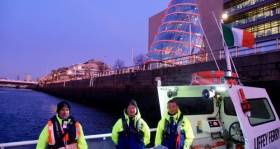Displaying items by tag: Anna Livia
Dublin's Liffey Ferry Service Starts for First Time Since 1984
#ferries - Dublin city had for the first time in 35 years, a new ferry service writes The Irish Times.
It was a cold, bright pre-dawn morning when the Dublin No 11 Liffey Ferry left its berth beside the MV Cill Airne at 7am for its maiden voyage as a passenger ferry.
The Liffey was like glass and as the boat turned east in the direction of the Tom Clarke (East-Link) Bridge, a beautiful red sunrise framed the Poolbeg Towers.
It was a perfect start. The only thing that was missing was passengers. There were none.
“It’s a bit early,” confessed Charles Sheridan, one of the three members crew on the No 11 for its first three minute trip across the Liffey to Sir John Rogerson’s Quay. “From a commuter point of view, the 7am start will take some time to generate traction.”
He was not fazed by the no-shows saying that the service will take some time to establish itself and they already have a group booked in from one of the many companies headquartered in Dublin’s Docklands.
For more on the relaunch of the ferry service and the related role of the East-Link bridge, click here.






























































